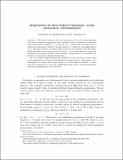Files in this item
Dimensions of sets which uniformly avoid arithmetic progressions
Item metadata
| dc.contributor.author | Fraser, Jonathan MacDonald | |
| dc.contributor.author | Saito, Kota | |
| dc.contributor.author | Yu, Han | |
| dc.date.accessioned | 2018-11-02T00:48:19Z | |
| dc.date.available | 2018-11-02T00:48:19Z | |
| dc.date.issued | 2017-11-02 | |
| dc.identifier | 251246863 | |
| dc.identifier | 0b781cd1-73ff-42cc-80ab-361edc0b1f9f | |
| dc.identifier | 000493552100008 | |
| dc.identifier | 85083968761 | |
| dc.identifier.citation | Fraser , J M , Saito , K & Yu , H 2017 , ' Dimensions of sets which uniformly avoid arithmetic progressions ' , International Mathematics Research Notices , vol. 2017 . https://doi.org/10.1093/imrn/rnx261 | en |
| dc.identifier.issn | 1073-7928 | |
| dc.identifier.other | ORCID: /0000-0002-8066-9120/work/58285470 | |
| dc.identifier.uri | https://hdl.handle.net/10023/16374 | |
| dc.description.abstract | We provide estimates for the dimensions of sets in ℝ which uniformly avoid finite arithmetic progressions (APs). More precisely, we say F uniformly avoids APs of length k≥3 if there is an ϵ>0 such that one cannot find an AP of length k and gap length Δ>0 inside the ϵΔ neighbourhood of F. Our main result is an explicit upper bound for the Assouad (and thus Hausdorff) dimension of such sets in terms of k and ϵ. In the other direction, we provide examples of sets which uniformly avoid APs of a given length but still have relatively large Hausdorff dimension. We also consider higher dimensional analogues of these problems, where APs are replaced with arithmetic patches lying in a hyperplane. As a consequence, we obtain a discretized version of a “reverse Kakeya problem:” we show that if the dimension of a set in ℝd is sufficiently large, then it closely approximates APs in every direction. | |
| dc.format.extent | 12 | |
| dc.format.extent | 336917 | |
| dc.language.iso | eng | |
| dc.relation.ispartof | International Mathematics Research Notices | en |
| dc.subject | QA Mathematics | en |
| dc.subject | T-NDAS | en |
| dc.subject.lcc | QA | en |
| dc.title | Dimensions of sets which uniformly avoid arithmetic progressions | en |
| dc.type | Journal article | en |
| dc.contributor.sponsor | The Leverhulme Trust | en |
| dc.contributor.institution | University of St Andrews. Pure Mathematics | en |
| dc.identifier.doi | https://doi.org/10.1093/imrn/rnx261 | |
| dc.description.status | Peer reviewed | en |
| dc.date.embargoedUntil | 2018-11-02 | |
| dc.identifier.grantnumber | RF-2016-500 | en |
This item appears in the following Collection(s)
Items in the St Andrews Research Repository are protected by copyright, with all rights reserved, unless otherwise indicated.

